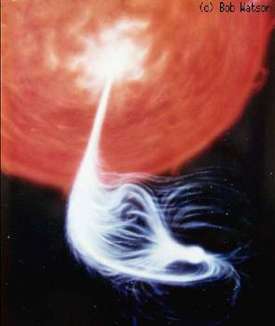South African Clone of Penn State Telescope Makes First Scientific Discovery

The new Southern African Large Telescope (SALT), an international partnership that includes Penn State, has released its first public research results, which will be published in the journal Monthly Notices of the Royal Astronomical Society. The research gives new insight into an exotic pair of stars that are closely orbiting each other, known as a "polar" binary-star system. These two stars are orbiting each other so closely that the entire system would fit inside our Sun.
SALT was patterned after the successful design of the William P. Hobby-Robert E. Eberly Telescope--one of the largest and most powerful telescopes in the world--which was conceived by Lawrence Ramsey, department head and professor of astronomy and astrophysics at Penn State, and Daniel W. Weedman, formerly a professor of astronomy and astrophysics at Penn State. The Hobby-Eberly Telescope (HET) is located at the McDonald Observatory in a remote area of West Texas, where night skies are among the darkest in the continental United States. "It is gratifying to everyone involved with the Hobby Eberly Telescope that the first scientific results with the Southern African Large Telescope will be published soon," Ramsey comments.
One of the stars in the polar system studied with SALT is an ordinary star like the Sun, but cooler, redder, and about one-third of the Sun's mass and radius. The other star is a compact object called a white dwarf--a star that shrunk to about one millionth of the volume of our Sun after it used up its original store of nuclear energy. This white dwarf is hundreds of thousands of times as dense of the Earth. A chunk of white dwarf as large as a pair of dice would weigh as much as two small trucks. This density gives the white dwarf an intense gravitational field that sucks in material from the larger star. This particular white dwarf has a huge magnetic field--30 million times as strong as the Earth's. "These are incredibly fascinating objects," remarked Penn State Professor of astronomy and astrophysics Donald Schneider, who has worked on these types of binary stars. "The magnetic fields are so powerful that they compress the infalling material into a funnel-like structure that impacts the white dwarf at a single spot: the magnetic pole of the star."
Polars are the most readily accessible objects for studying gas accretion in strong magnetic fields. They also are among the most closely orbiting pairs of stars known. The polar that astronomers studied with SALT takes only one-and-a-half hours to complete an orbit, compared to a month for the Earth and moon, and a year for the Earth and Sun.
The radiation emitted as the gravitational field of a compact star gobbles gas from its companion star is one of the indirect ways astronomers detect black holes. It also is the way that mass builds up on some compact stars until supernova explosions blow them apart, producing the 'Type Ia' supernovas that astronomers have used recently to show that the expansion of the universe is speeding up.
The innovative, precision design of the HET dramatically reduces construction costs and has opened the door to a new era for such large-sized telescopes, including SALT, which was inaugurated in November 2005. The HET received the Discovery Magazine Award for Technological Innovation in 1997.
This first research result from SALT uses a strength of the telescope's design that is rare among large telescopes, the ability to take 'snapshots' of stars in very quick succession, making it possible to study the rapidly changing properties of compact stars, especially as they pull in gas from their companions or surroundings. SALT's advantages for this type of research are expected to allow SALT astronomers to be among the leaders in probing the mysteries of these 'cannibal stars'.
Source: Penn State




















